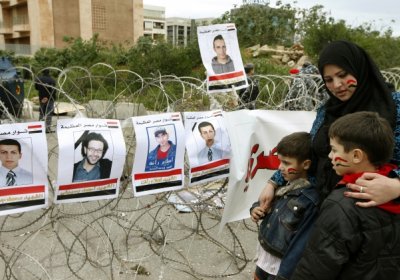Protests at Cairo's Tahrir Square and other cities across Egypt on July 8 drew hundreds of thousands back to the streets to "save the revolution".
The protests are part of the ongoing struggle to press for democracy in the aftermath of the popular uprising that overthrew dictator Hosni Mubarak in February.
The protests, labelled “Friday of Justice for Revolution Martyrs” by the Facebook group We are all Khaled Said, has also been dubbed “Persistence Friday” in the media.
Egypt
The revolutionary struggle for democratic and economic freedoms continues to grow in Tunisia and Egypt in the aftermath of the ousting of dictators Zine el Abidine Ben Ali and Hosni Mubarak.
Western powers are working to block these struggles — just as they supported the fallen dictators until the very end.
Vast sums of money have been pledged by the United States, European Union and the Group of Eight (G8 — the US, Britain, France, Germany, Italy, Canada, Russia and Japan) to aid what British Prime Minister David Cameron termed “democracy, freedom and prosperity” in the Middle East.
As many as 1 million people gathered in Cairo's Tahrir Square and across Egypt on May 27 for a “Friday of Anger”. The huge march showed the revolution that ousted dictator Hosni Mubarak in February has reached a new stage.
The demonstrations were called by left organisations in defiance of Egypt's military rulers — as well as the Muslim Brotherhood and liberal groups that were part of the mass protests against Mubarak in February.
“To continue this revolution, Egypt must go to Palestine.”
These were the words of Akram Ismalii, a student from Cairo University who marched along side his classmates in downtown Cairo for the Third Palestine Intifada rally on May 15. The day marks al-Nakba ("the catastrophe"), as Palestinians call the anniversary of the expulsion of hundreds of thousands of Palestinians from their homes and land in 1948.
It was rumored it would be a 1 million-person march, but the protests led by pro-Palestine demonstrators may have disappointed in size, but delivered in passion.
The streets of Cairo have been the frontier for a range of demonstrations over the past two weeks. A Day of National Unity between Christians and Muslims was held on May 13.
Shortly after the end of World War I, Australian troops bloodily suppressed a popular independence revolution in Egypt.
This overlooked episode in Australia’s military history has never prompted much national soul-searching — but it should. The war in which some 60,000 Australians died was supposedly fought for liberal democratic values and the right of peoples to pursue national “self-determination”.
Episodes like the Egyptian revolt suggest that a squalid imperial reality underlay the noble rhetoric, which is why it has been relegated to obscurity.
The Egyptian army has violently cracked down on pro-democracy protesters in Cairo’s Tahrir Square on the night of April 8, BBC.co.uk said the next day.
Medical sources said two protesters were killed and the health ministry said 71 were hurt.
Protesters were demanding greater changes from the interim government that took over after dictator Hosni Mubarak was overthrown in February, including demands that Mubarak be made to stand trial.
Protesters re-occupied Tahrir Square on April 9, BBC.co.uk said.
The much-feared secret police and intelligence service that protected the regime of former Egyptian President Hosni Mubarak by arresting, torturing and even killing opponents has begun burning documents and evidence that could incriminate them.
This comes as calls escalate to abolish the force altogether and bring its officers to justice.
Hundreds of protesters surrounded the main office of Amn al-Dawla, the State Security Police, in 6th of October City, on May 5 to try to stop the burning of files.
Protesters shouted: “Justice, justice for they fired bullets on us.”
There was another win for “people’s power” in Egypt when interim prime minister Ahmed Shafiq resigned on March 3.
Shafiq was sworn in by the overthrown dictator Hosni Mubarak and is closely associated with the old regime.
He was replaced by former transport minister Essam Sharaf, who was asked by the military government to form a cabinet in the lead-up to elections scheduled for later this year.
Hidden beneath the spectacular street battles that forced Egyptian dictator Hosni Mubarak out of office was a trigger that exists in dozens of countries throughout the world — food.
Or, more specifically, the lack of it.
Commentators have focused on the corruption of the dictatorship, or the viral effects of the Tunisian uprising or what appears to be akin to an Arab political awakening.
But the inability of the Egyptian regime to ensure a steady flow of food staples should also be viewed as a critical factor driving this seemingly spontaneous movement for freedom.
The Egyptian people’s revolution has entered a new phase after the fall of dictator Hosni Mubarak on February 11.
The first reaction to Mubarak’s resignation after 18 days of continuous protests was one of celebration.
Cairo’s Tahrir Square, the centre of the uprising, turned into the scene of a giant party for days afterwards in celebration of the exit of Mubarak, who had ruled Egypt for three decades.
Undoubtedly, the widespread feeling was that it was time to begin building a “new Egypt”.
Venezuelan foreign ministry official statement The president and commander-in-chief of the Bolivarian Republic of Venezuela, Hugo Chavez, in the name of the Venezuelan people, applauds the genuine lesson of political and democratic maturity that the courageous Egyptian people have brought before the eyes of the world.
- Previous page
- Page 6
- Next page











